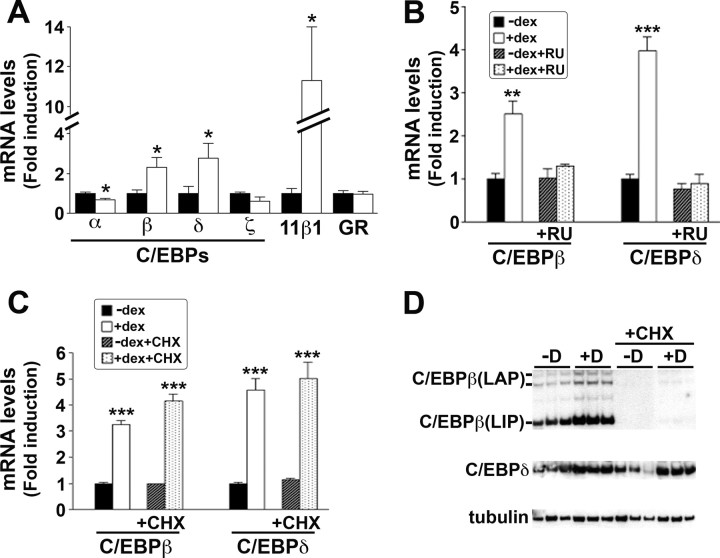Fig. 5.
Dexamethasone Increases C/EBPβ and -δ Expression in A549 Cells
A–C, Real-time PCR measurement of levels of mRNAs encoding members of the C/EBP family in vehicle-treated A549 cells (black bars) or after 10−6 m dexamethasone treatment (white bars). Levels of mRNA are expressed as fold induction, relative to levels in vehicle-treated cells. Data are mean ± sem of three to 12 independent mRNA samples. *, P < 0.05; **, P < 0.001; ***, P < 0.0001. A, Levels of C/EBPβ and C/EBPδ mRNAs were induced after 24 h dexamethasone treatment. B, The induction of C/EBPβ and C/EBPδ was abolished by prior incubation with 10−5 m RU486 (RU), added 30 min before dexamethasone. Hatched bars, RU486; spotted bars, RU486 and dexamethasone. C, Cycloheximide (10−5 m), added 30 min before dexamethasone (4 h), had no effect on the induction of C/EBPβ and C/EBPδ. Hatched bars, cycloheximide; spotted bars, cycloheximide, and dexamethasone. D, Representative Western blot, probed with C/EBPβ, C/EBPδ, or tubulin antibody, of 20 μg protein extract from triplicate samples of A549 cells treated for 24 h with vehicle (−D) or 10−6 m dexamethasone (+D), with or without cycloheximide (CHX), as indicated. Sizes of protein markers are shown on the right. Immunoreactive proteins corresponding to the LAP (38 and 35 kDa) and LIP (20 kDa) isoforms of C/EBPβ are indicated.

